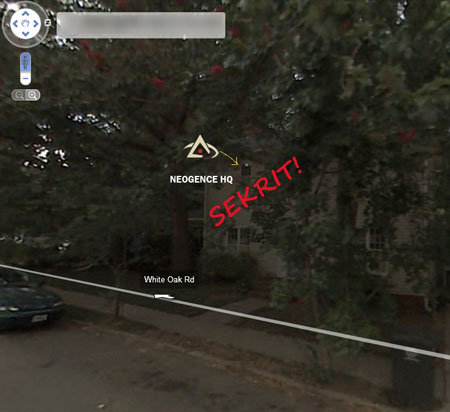
Neogence is on stealth mode with an immersive mobile augmented reality platform – “tools, sdk, and infrastructure plus some applications.†They are probably six months away from YouTubing anything according to CEO, Robert Rice. But Robert rustled up this pic for me – a Google street view of Neogence R&D labs: “the patio on the lower left is where I do a lot of pacing and smoking my pipe and the porch and office upstairs is where a lot of meetings have been held.â€
Robert Rice (@RobertRice ), CEO of Neogence, recently tweeted:
I’m changing my name to Robert Mobile Ubiquitous Geospatial Augmented Rice. I’m betting on radical changes in next 18 months.
Although Robert’s new AR platform is still under wraps, I think you will get a good idea of what direction he is going in from this interview (full text at end of this post). Robert is the author of “MMO Evolution†and is a key developer and thought leader in persistent immersive environments, simulations, virtual worlds and massively multiplayer games as well as large scale communities and social networking.
It is OMG finally, at least, for minimally immersive but truly useful AR.
Since the launch of Android a new generation of useful augmented reality applications like Wikitude are emerging.
After the last NYC Tech Meetup, my friend Nathan Freitas, (@NatDefreitas), or rather Nathan Mobile Meets Social Freitas, demoed for me a cool graffiti app he has developed on Android.  You leave a marker for your graffiti so other people can find view/add their own – a nice primal experience like pissing on the lamp post to let your pack know where you’ve been. Also the graffiti app taps into a long history of NYC street culture around tagging and graffiti art. For more cool mobile projects Nathan is working on – Vote Report and data collection for mass events, a guide to pubs and nightlife in New York City, and more, see his blog, “Nathan’s OpenIdeals. With Camera, GPS, compass, and accelerometer, and APIs on Android for temperature, light meters, (no hardware yet), Nathan says Android:
“seems to be the platform most likely to socialize the idea that sensor data could be a piece of every application.â€
As Nathan is fond of saying:
The compass is a killer app enabler!
Also see OpenIntents for some interesting Android Sensor projects.
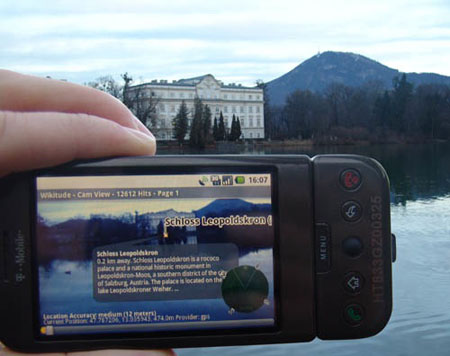
Wikitude was one of Thomas Wrobel’s two top AR milestones for 2008 (see Gamesalfreso):
Wikitude I think. Seems the first released, useful, AR software.
AR Geisha doll is also a remarkable breakout for AR – but useful, nah.
I asked Robert if he also thought Wikitude and AR Geisha doll as significant breakthroughs:
Yes, these are among the first attempts to get away from the novelty of simply rendering a 3D object based on a marker and making it interesting.
Remember, one of the biggest risks that AR has, is being branded as “noveltyâ€, which means “cool for five minutes but ultimately a waste of time.†I think we have a ways to go before something is truly useful, but as 2009 progresses we should start seeing some effort here. I’d guess 2010 before something really useful comes out…at least something practical.
Now, having said that, I should say that I expect entertainment and games to take the lead (as usual), although there are a few companies really trying to leverage AR and video/graphics compositing for marketing (brochures) and location based methods (kiosks, large screen projections, etc.)
So when is it “OMG finally!†for massively multiuser augmented reality?

The picture above is from benjapo’s portfolio on istockphoto – also see the istock video here.
Alex Soojung-Kim Pang (who weighed in recently on the twitter-baby debates – see my KickBee Posterous blog) challenges design assumptions for augmented reality that take as a given the user’s desire for numerous private enhancements to their reality.
Alex points out less will probably be more so that enhancements do not impinge on shared experience. See his write up of a talk he gave at the Royal College of Art, “and the end of my own private Shibuya.†Photo below by Stéfan, “Karaoke in Shibuya“
Part of the pleasure of these streetscapes is precisely that they’re collectively experienced, rather than individual visions: for even a brief period, we share with other postmodern, globe-hopping flaneurs and expatriates and temporary natives the light of the ABC-Mart sign and storefront.

It is collective experience of enhanced, augmented, virtual or real experiences that interests me too. This is one of the reasons I find Pachube and the EEML project of Haque Design and Research so interesting.
Extended Environments Markup Language (EEML), a protocol for sharing sensor data between remote responsive environments, both physical and virtual. It can be used to facilitate direct connections between any two environments; it can also be used to facilitate many-to-many connections as implemented by the web service Pachube, which enables people to tag and share real time sensor data from objects, devices and spaces around the world.
“Distinctions between virtual and real are as quaint and outmoded as distinctions between mind and body†(Usman Haque)

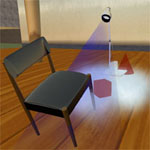

Usman Haque (founder of Pachube and Haque Design and Research) points out this is an underlying premise of his work – and augmented reality (full interview coming up soon!).
The pictures above show the Haque Design project, Remote:
‘Remote’ connects together two spaces, one in Boston the other in Second Life, and treats them as a single contiguous environment, bound together by the internet so that things that occur in one space affect things that happen in the other and vice versa – remotely controlling each other.
There was a discussion in twitter recently about how the terms like Second Life, Exit Reality, Virtual Worlds are misleading and outmoded. As Robert pointed out we need:
one word please…that sums up virtual and/or augmented reality, interactive, immersive, virtual worlds, mmorpgs, simulations, etc… also, I really don’t like the term “augmented reality†or “mixed realityâ€. Neither is all that great. And NO “matrix†or “metaverse†please
Robert argues strongly that there is a stultification both in virtual world technology – much of what we call virtual world technology was already, basically, where it is now in the mid 90’s. And MMOGs have devolved into gameplay design “that emphasizes the single player experience and does nothing to take advantage of the potential of the massively connected internet.â€
Robert suggested I take a cruise through a new Virtual Space - CoolIris to find some good pictures for this post (note the partnership between CoolIris and Seesmic to Streamline Video Blogging. I added the Cooliris Plugin to Firefox and typed Augmented Reality into search and soon I was cruising a highway of images and links. The Road Map image grabbed my attention (see below). It shows the continua that the Metaverse RoadMap authors thought are likely to influence the ways in which the Metaverse unfolds. It is “a map of the spectrum of technologies and applications ranging from augmentation to simulation; and the spectrum ranging from intimate (identity-focused)external (world-focused)â€
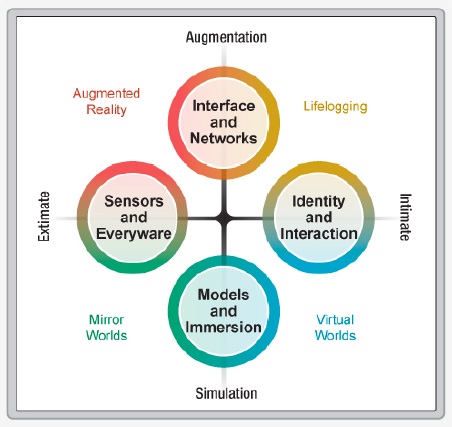
Quite to my surprise, when I clicked out of CoolIris to the source for the image, I found it had been drawn from a post I wrote in May 2007, Hybridized Digital/Physical Worlds: Where Pop and Corporate Cultures Mingle. My post talks about a number of hybridization experiments that were bringing together lifelogging, sensors everywhere, simulation, virtual worlds, and augmentation.
The striking difference from 2007 to now is that we have definitely moved on from mere experimentation. And the poles of the continua intimate/extimate, augmentation/simulation as expressed in the Metaverse Roadmap are now becoming entwined (note the picture above seems to be slightly different to the one used in the road map as published here – perhaps I had an early version?)
“Augmented Reality is not just about overlaying data…” (Robert Rice)
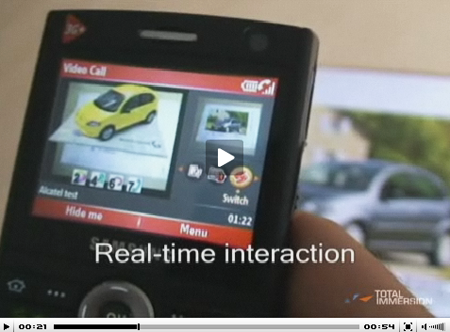
The screenshot above is from TotalImmersions video demoing Augmented Reality with 3D Cell Phones. Also see video of their immersive games, and FutureScope kiosks here and here.
Gamesalfreso noted that Will Wright, delivered the best augmented reality quote of the year. When describing AR as the way of the future for games, Will Wright said:
“Games could increase our awareness of our immediate environment, rather than distract us from itâ€.
Robert points out in this interview the term Augmented Reality itself has become associated with a very limited understanding of what “enhancing your specific reality,†is really about. Robert notes:
it is inherently about who YOU are, WHERE you are, WHAT you are doing, WHAT is around you, etc.
When I talk about AR, I try to expand the definition a little bit. Usually, when you talk to someone about augmented reality, the first thing that comes to mind is overlaying 3D graphics on a video stream. I think though, that it should more properly be any media that is specific to your location and the context of what you are doing (or want to do)…augmenting or enhancing your specific reality.
In this sense, anything that at least knows who you are (your ID, mobile phone #, etc.), where you are (GPS coord or a specific place like a cafe), and gives you relevant data, information, or media = augmented reality. Sure, you can make things more interactive or immersive, but that is the minimum.
So, in this case, yes, I think there will be networked applications in the next 18 months…mostly things that are enhanced by friends lists (you are here, your friend is over there). These will be *application specific*. My team at Neogence is already going beyond this, building a platform and infrastructure for other applications to be developed on…all networked through the same backbone. Now, in this context (the science fiction AR that we all dream about), no I do not see anyone else trying to leap a generation or two ahead of the industry to build a massively multiuser shared AR space. Expect to see things like multi-user AR games, virtual pets, kiosk marketing, magic book, “gee whiz†presentations (tradeshow booths, entertainment parks, etc.), and so forth.
Goggle’s Are Not The Secret Sauce…
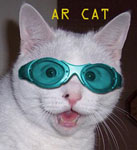
![]()
AR Cat left and Robert Rice right
What has come to be associated with the term Augmented Reality, in the popular imagination – an idea of 3D graphics projected over markers that has been forever waiting for the advent of “wicked next generation transparent wearable displays†– nirvana for augmented reality. While such displays may be nirvana for AR (and they could be with us in less than twenty four months), Goggles are not the “secret sauce†of AR as Robert points out.
All the glasses are, is another display device. At the end of the day, it doesn’t matter if you are looking at an LCD monitor, an IPhone, a head mounted display, or a pair of wicked next generation transparent wearable displays that magically draw directly on your retinas.
The real tricky stuff is what happens on the backend…making it all persistent, massively multiuser, intelligent, interoperable, realistic, etc. etc.
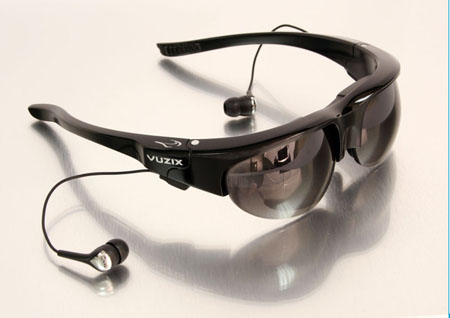
There has been quite a buzz going around about the new Vuzix Eyewear, and recently Robert talked with Vuzix and checked The Wrap 920AV eyewear out:
Vuzix is not alone in pursuing the ultimate in hardware, at least as far as wearable displays. However, I think they are much farther than the rest of the pack in vision, roadmap, and execution. They have put together a team that has a sense of urgency and ambition that will blow the industry away. After talking to them, I got the feeling that they really know what they are doing and there is a lot of mind blowing stuff in their pipeline. I’m sure they are one of the few companies that really gets it and has a clear vision of the future. Definitely my first choice to work with.
Hybrid Augmented/Virtual Reality
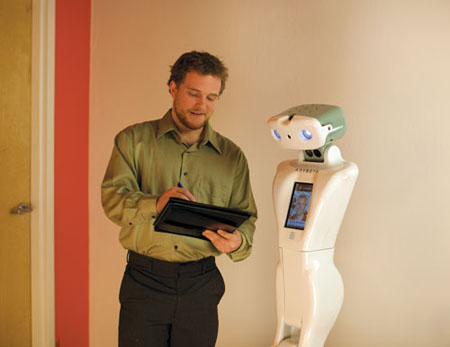
Cory Ondrejka posted this picture of the anybots telepresence robot and “congrats to Trevor Blackwell and the rest of the Anybots team on the launch of QA at CES.â€Â Cory (one of the founders and former CTO of Second Life) also made some predictions for Virtual Worlds, some optimistic and some less so, including “the increasing need to be able to diversify the Second Life product offering to begin truly rebuilding the code base.â€
Robert is unabashedly irritated with the state of play in Virtual Worlds and MMOGS:
Unless both industries (Virtual Worlds and MMOGs) have some serious upheaval or radical new approaches, they will quickly be eclipsed by AR, which will eventually evolve into something hybrid..AR/VR depending on your level of access and hardware.
I’d like to see someone grab an engine like Offset, Crytek, HERO, or Unreal 3, and smack on a fat MMO server infrastructure (Eve or Bigworld)…toss in the right tools, and you would see a revolution and renaissance occur at the same time in the virtual world space. All the puzzle pieces are there, just no one is putting them together the right way.
I did just find out that Nortel’s WebAlive is powered by the Unreal 3 engine. You can try WebAlive out here.
Robert points out how rare it has become to see people really push virtual worlds technology and MMOGs into entirely new directions. Although, of course, there are exceptions. I managed to engage some interest from Robert in the possibilities the opensource modular architecture of OpenSim opens up, and the augmented reality experiments from Georgia Tech with Second Life (screenshot below) got praise from Robert for trying to do something new. (Georgia tech have also put out a virtual pet app for the iphone ).

But while Robert clearly has zero patience for virtual world technology which he sees stuck in the mid nineties, he notes:
the innovative and wonderful stuff about SL isn’t SL, it is what people are doing and creating on their own with terrible tools *IN* SL [Second Life].
The immersive mobile augmented reality platform Robert is building, he hopes, will generate this kind of user creativity but with 21st century tools.
So is it “OMG†finally for the Augmented Reality we have dreamed about?
According to Robert:
It really boils down to a markerless solution and a good application.
In the interview below we cover a number of topics including business models for Augmented Reality, e.g., how business models based on micro-transactions and virtual goods will translate to Augmented Reality.
Many of the challenges to becoming mainstream faced by virtual worlds are similar to the challenges AR must overcome. Robert discusses these including the interface/gui that is a critical element for AR, solving the riddle of one world or many, patent wars in Virtual Worlds and Augmented Reality, the role of Augmented Reality in the future of sustainable computing, and what interoperability is about.
The Back Story for AR/VR…
In case you want to get up to speed on the required background reading for Augmented Reality. This is Robert’s required reading list and Denno Coil is an absolute must see (feel free to add to this list in the comments, please).
“If you want to see the things that have inspired our vision of what we want to build, check out:
* Dream Park by Larry Niven and Steven Barnes
* Rainbows End by Vernor Vinge
* Spook Country by William Gibson
* Halting State by Charles Stross
* The Diamond Age by Neal Stephenson
* Donnerjack by Roger Zelazny and Jane Lindskold
* Otherland by Tad Williams
* Neuromancer by William Gibson
* Idoru by Wiliam Gibson
* Cryptonomicon by Neal Stephenson
and watch the whole anime of Denno Coil (subbed NOT dubbed!)â€
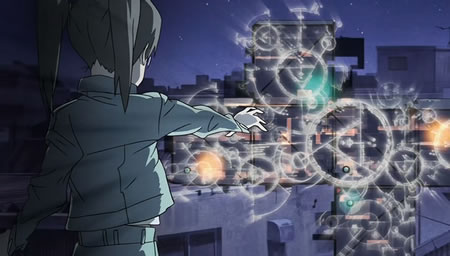
Screenshot from Denno Coil from Concrete Badger.
Interview With Robert Rice
Tish Shute: I am glad to hear that you are working on this [an immersive mobile augmented reality platform]!
Robert Rice: We switched gears from MMO stuff about a year ago and we are finally getting some traction. It is very hard doing anything in this economy right now, but we found an opportunity to take AR to a new level beyond what you see on youtube. AR is still too “cute†and novelty. We don’t want to play around.
Tish Shute: I like Wikitude ‘cos it even manages to do something useful!
Robert Rice: Yeah, useful = traction. Now that we are getting near a prototype we are starting to get a lot of interest even though we are still technically way under the radar.
Tish Shute: r u funded?
Robert Rice: privately funded, some revenues from an early license, and ongoing discussions with several institutional investors. So, we have some funding, but nothing spectacular just yet.
Tish Shute: are you just developing an AR platform?
Robert Rice: hrm, sort of, but not just that. By platform I mean tools, sdk, and infrastructure plus some applications. The idea is to build something that facilitates everyone else making cool things and useful applications for different industries/sectors
Tish Shute: Yes that is the cool thing to do but isn’t that hard to fund!
(Robert grins) Well, that depends on the business model. We’ve got that figured out. I’d be absolutely happy if everyone and their brother were making applications on our stuff that gives us an edge on market penetration/saturation. There are plenty examples that prove the model. If you give people free and easy to use tools, they will run with it. ARtoolkit for example, has tons of people making nifty things and posting videos on youtube that has pushed them to the forefront as THE AR middleware to use right now, or heck, look at youtube free service, and they dominate video sharing. Sure there will be a lot of “noiseâ€, but there will also be a lot of “signal†that will rise to the top, facilitating and enabling is creating value in its own right.
Tish Shute: But how do you expect to monetize?
Robert Rice: There are a good half a dozen ways to monetize AR or an AR platform.
Tish Shute: What are your top 3?
Robert Rice: hrm, microtransactions, localized mobile advertising, and enterprise solutions (visualization)
Tish Shute: Do you think the consumer market will give the lead?
Robert Rice: I’m not sure. We are getting people from academia, intelligence, defense, border security, and some corporate types knocking on our door already, and pretty aggressively. It may be that those sectors push AR before consumer entertainment really kicks off.
But going back to a discussion we had earlier – yes working with “no markers†is a big deal.
Tish Shute: Can you talk about what you are doing there or is it still under wraps?
Robert Rice: I can say that between some university tech transfer and some of our own proprietary stuff, we are using some fairly common visual tracking technology. if you are really plugged into the AR scene, you will know there are probably half a dozen visual tracking methods out there. We just looked for the best one, licensed it for commercial use, and then started working our magic. This is a very small piece of the overall effort, but worth noting.
The downside with working with university tech is that it is usually based on research, incomplete, and not wrapped up in a nice commercial package on the upside, it can be a good start to build on.
Tish Shute: As you know I am very interested in “technology that matters†in particular tech that can help us accomplish the urgent goal of sustainable living.
Robert Rice:: oh, I’m pretty keen on sustainable living as well…after I sell off a few companies and have money of my own, I’m going to get into arcologies
â¦
Robert grins
The interesting thing with the visual stuff combined with our other tech, is that we can make things multiuser, persistent, dynamic, and mobile.
The markers (fiducials) are really really limiting outside of basic applications. You can’t really plaster everyone and everything with a marker. And they are, by nature, static (even if they are animated or whatever).
Also… our stuff works indoors and outdoors even without a GPS connection.
â¦
Robert grins
Tish Shute: Now that does sound interesting!
Robert Rice: Yeah, with visual, you don’t need a compass or accelerometers either. Less hardware : )
You start with wifi triangulation or gps coord to get a “brute†location, and then you use the visual stuff for down to the meter accuracy and that by nature, gives you your orientation and positioning.
Tish Shute: Wow this is beginning to sound very interesting!
Robert Rice: Once you have that, it doesn’t matter where you go, it continues to track and continually refines areas you have been before. We’ve spent the last year figuring all this out. There are so many problems and obstacles that are going to be developing in the future for anyone trying to do what we are, but we have already discovered solutions.
oh, visual tracking = gesture based interfaces too that’s going to take some work, but its doable. The real pain in the ass there isn’t the actual tracking, it is in the interface design.
That’s something that almost every AR company, venture, and research program is missing out on entirely. They are so focused on making cute things with markers. They are missing the larger problems of AR Spam, interface, iconography, GUI, metaphor, interoperability, privacy, identity.
Tish Shute: So how are you dealing with all that!!
Robert Rice: We took the backwards approach of trying to think where we want things to be in ten years (and we read all the cool books…Vinge, Stephenson, Gibson, etc.) and then we spent time trying to think of what the potential problems are….like AR spam. Its bad enough when a giant penis flies by in second life, we don’t want that to happen in a global wireless AR platform.
Tish Shute: Do you have a prototype yet?
Robert Rice: hrm, 6 months away from youtubing something. Problem has been slow funding, which equals slow development. We also don’t want to show our cards too soon…too many potential competitors out there.
â¦
Robert grins
Tish Shute: when you say microtransactions what is the business potential there?
Robert Rice: hrm last year I think, $1.5B was spent on virtual items. That’s games and virtual worlds. That should hit $5B in a couple of years. That’s basically people buying and selling things like WoW gold or items in SL or whatever. microtransactions, is basically the same thing, but in AR space.
Why couldn’t a 3D artist make a wicked animated 3D dragon, and then sell it to someone else? With AR, you could sit it on your shoulder. With a good scripting engine, you could train it to do stuff. Thats what I want to enable.
tools + sdk + platform = enabling people to make and create. Add in a commerce level (microtransactions) and wala.
Tish Shute: At the moment all of these virtual goods are very platform specific, is that a problem for you?
Robert Rice: Not at all. This is at a higher level. You have to switch mental models when you talk about what AR could or should be. For example, lets contrast the web and virtual worlds. For every virtual world you go to, you have to download a whole new client. Imagine if that model was applied to the web… you would need a brand new browser for every website you went to. That is just so…wrong.
It’s the same thing for AR…people are thinking about it with the same mental and business models and development philosophies as virtual worlds or web. There are some things and aspects that work fine, but not everything.
Virtual worlds, are, by nature, necessarily different and walled gardens. The idea of 100% open and interoperable virtual worlds is a red herring…it sounds good but in practice it is a really dumb idea.
Tish Shute: I was wondering if you had a way to leverage all the 3D content already created ‘cos that would jump start things in AR wouldn’t it?
Robert Rice: Oh yeah, that’s easy. They all use the same polygons. Any virtual item in any game or virtual world is likely created with 3D studio or maya or something similar would be easy to convert and use.
Tish Shute: So people could bring their WoW weapons into your system?
Robert Rice: Not legally, but sure. Its just a 3D model with a texture. It doesn’t matter if you use corel draw or photoshop or paintshop pro….or one screwdriver or another. Part of my team’s advantage, is that we are all experienced in MMORPG and virtual world design and development. We know the tools, the tech, and what works and what doesn’t.
Tish Shute: But some of the 3D content created in the social worlds is what has most value to people.
Robert Rice: Right, and that can be exported out easily.
Tish Shute: But back to “real†life applications. Is you platform really markerless?
Robert Rice: Yes. marker = printed icon or glyph, also known as a fiducial
Tish Shute: But u must have some marker?
Robert Rice: hrm, more accurately, you need a point of reference.
Visual tracking has been around for more than a decade. Lots of work for robots and other sectors.
Robert Rice: But isn’t the specificity of reference n terms of RL applications a vital key, for example, for a database of things?
Robert grin That is a different problem…tracking, registration, mapping, positioning, etc. That question has to do with mapping which is related to visual tracking, but not the same thing. We have a rather unique approach to some of this that I can’t discuss (patent pending).
Tish Shute: But for example, to create an augmented natural history of food – say I want to point at the slab of meat on my plate and know where that cow came from, what feed lot how it was treated etc
Robert Rice: That is not possible without ubiquitous nanotechnology. Shall I explain?
Tish Shute: Yes please!
Robert Rice: Ok, lets step back a minute and turn that burger back into a cow… the first problem (of this particular situation) is differentiating from one cow to another since most cows look alike, you can either attempt to discriminate visually (cow patterns) or use a much simpler option, like giving each cow a rfid chip in their bell, or hoof
Now, most people would try to figure out how to jam all sorts of info in the rfid chip, which sounds like a good idea, but isn’t, the trick would be to simply use the rfid to store a unique identifier with is then linked to a database elsewhere, or hoof.
That database should continually be updated with whatever relevant information you need so as you get close with your AR laptop, wearable displays, or embedded brain chip, you get the identifier broadcast, then you get the info downloaded to you, and it “sticks†to the cow with the generic visual tracking (object following, even simple bounding box is sufficient for a slow moving cow)
So, up to that point, you can get tons of information about that specific cow, that cow population (remember, AR is not just about overlaying data…it is inherently about who YOU are, WHERE you are, WHAT you are doing, WHAT is around you, etc.) Tie in data visualisation and some farmer tools and all sorts of other things happen. Now, lets move the timeline ahead a bit.
The butcher gets the cow and does his handiwork…because we know all the info about the cow, all of the meat can be properly labeled and marked. Ideally, with a UPC code or a unique glyph (somewhat problematic depending on how many unique glyphs you can create) so, while you are in the grocery store, you can access the relevant shopping data…age of cow, state of origin, type of feed, how many spots, how much body fat, which butcher, whatever not because of what is inside the package, but the package itself.
Getting back to your hamburger, the problem is that it is a burger…there is nothing to distinguish that burger from another one at the table…unless you stuck a rfid chip in it or splattered it with ink and a unique glyph, or maybe a special one of a kind plate.
However, a properly designed AR system could say “hey! that/s a hamburger! and I know I am at Fat Daddy’s Burger Joint in Raleigh North Carolina on Glenwood Avenue, and I know that they cook their burgers this particular way, and their meat supplier is those guys over there, and they usually get their cow meat from a farm out in Utahâ€
With ubiquitous nanomites or whatever, then its not that far out to consider edible nanos that are in the meat and that broad cast info so a slab of meat can tell you about itself and broadcast that to the general public.
Tish Shute: What useful scenarios can we create without the nanomites?
Robert Rice: If it wasn’t a burger or a consumable organic, the scenario changes.
Tish Shute: What is the time scale on nanomites?
Robert Rice: ehhhhhhh 20 years minimum if we are lucky. They sound good on paper, but there is a whole book worth of problems and why they are so far off…as consumer grade, all over the place, type of stuff.
Tish Shute: Did you see the Nokia Home Control center?
Robert Rice: Yes, I saw the Nokia stuff.
AR for sensors, like security systems, temperature control, etc. all become “sources of data†that a AR system can visualize. So yes, thats easily doable. You could do that in a short period of time with some half decent engineers.
The trick of what Nokia is doing is aggregating sensor data from a building/home/facility, mashing it together, and sending the mobile device alerts and data visualization conceptually rather simple, but no one has done it right or well yet.
It wouldn’t surprise me if Nokia pulled it off.
Tish Shute: yes and if they do and someone does an AR interface to it that would be an inflection point for AR?
Robert Rice: In a roundabout way, yes. You could get data directly from your house, or get it through your mobile device and in either case, use the AR for visualization and control.
The interface/gui is a critical element for AR. That is one of the areas where it, as an industry, risks doing a bad job and turning into just a fad or another novelty like VR. Virtual worlds have been struggling with that for a while, but MMORPGs have had the effect of extending their life cycle
Tish Shute: Yes VWs have not solved the interface problem.
Robert Rice: The interface is one of their problems yes. Most virtual worlds are stuck in 1996/98
Tish Shute: If ARÂ is inherently about who YOU are, WHERE you are, WHAT you are doing, WHAT is around you, etc. seems that it is the ideal interface for home control?
Robert Rice: Well for home control, you must know:
1) Who am I? Am I authorized to know this information? Am I a guest?
2) Where am I? Is this my house? or someone elses?
3) What am I doing? Do I want to make all the doors lock? Turn on or off lights? Open the garage door? Trigger the security alarm?
So the same questions apply
I’d say that all virtual worlds are stuck in the mid 90s. They are at least a decade behind the game worlds…in technology, design, implementation, architecture, etc. etc. In my opinion, things like Second Life are shameful in how they are presented as state of the art, innovative, ground breaking, new, wonderful, and world changing.
But thats another topic of conversation : )
Tish Shute: Well for me the contribution of VWs is the presence enabled real time interaction with application (as 3D info machine) and context with other people.
Robert Rice: Oh,there is no doubt that they are greatly useful and have a phenomenal amount of potential.
They *could* be all those things I just said that SL isn’t…the problem is that they are either just existing, or they are meandering around without any real focus or direction. They aren’t evolving.
Even MMORPGs are losing their way and beginning to stagnate terribly
Tish Shute: yes I agree
Robert Rice: But, AR has the potential to change a lot of things.
Im sure you have seen the yellowbook commercials? The technologies you are seeing here are doable in hrm, a year or less maybe. The tricky part is the interactivity and AI…that is, the content. Everything else isn’t a problem. The avatar there could be photorealistic or stylized like a WoW character.
You could do that to some degree with markers for registration but dynamically changing the content linked to those markers is a little weird
(by the way, for the record, I like markers just fine, I just don’t think they are useful for real-world mobile applications)
I also think that the guys that want to dust the planet with miniature rfid chips are on crack and are going about it the wrong way
Tish Shute: A high level of interactivity is hard though. Isn’t it? Even in VWs it is very limited.
Robert Rice: it depends if you can track what the user is doing, and interpret that properly. Interactive is also a very lose term.
Clicking a button and making a light blink could be considered interactive.
Tish Shute: In VWs a high level of interactivity would be to wield a virtual hammer and have a real nail go in! is physics part of the problem?
Robert Rice: physics aren’t difficult, plenty of middleware out there for it. The problem with that isnt so much the physics as much as it is the scale and purpose
Tish Shute: well for robotics?
Robert Rice: that gets into a conversation about meshes, textures, and volumetric collision detection and stuff
Tish Shute: virtual robotics?
Robert Rice: You mean teleremote/telepresence of real robots?
Tish Shute: yes!
Robert Rice: ah, for that, you need some tactile feedback and some other stuff – doable, but insanely difficult. That’s why you don’t see a whole lot of remote controlled surgery robots all over the place.
They do exist…
Tish Shute: Will AR contribute to sustainable living by freeing us from some of our energy hogging devices?
Robert Rice: AR will ultimately encourage energy saving and recycling. where did I leave a light on at? where is the nearest trash can? what is the UV index outside today?
Yes, computers are energy hogs, but as we start seeing larger SSD drives, more efficient CPUs (even if the number of cores increases in multiples), and so on, the power will go down.
Also, think about this…wearable displays potentially use less energy than LCD monitors on your desk.
Tish Shute: Yes I should pick the brains of my intel chums on energy saving!
Robert Rice: Getting rid of the monitor and switching to solid state drives will save an assload of power. Yes, I said assload.
Tell your intel chums to quit screwing around with single core mobile CPUs. We need multiple cores, that are smaller, faster, and use less power.
Tish Shute: Is AR is the sustainable future of VW and MMOGs?
Robert Rice: The fun stuff will happen when they are both integrated in some fashion.
Tish Shute: So perhaps this is why the Georgia guys are thinking in trying to combine AR and SL (see video here).
Robert Rice: That first video was pretty damn cool. It just pains me that they are using SL for it. And omg, all those markers on the table.
Although, I could care less about seeing my SL avatar on my coffee table. I would rather see an avatar representing ME in the real world, moving around in a virtual world that is a “to scale†replica of the real world. That is MUCH more interesting and innovative.
But even if I don’t like where they are going, or that they are using SL, the important thing is that they are doing something and forging ahead. I have a massive amount of respect for anyone, private, government, or academic, that is doing that.
And yes, the door (or window, or looking glass) has to work both ways for maximum potential, at least, that’s what Id like to see. They don’t *have* to, but it would be rather cool.
And going back to sustainability, AR has the potential to make monitors generally obsolete, laptops too. That’s a lot of power hungry devices with all sorts of metals and batteries inside.
But, even if the tech was absolutely crazy awesome right this minute, it would take a little while for consumer adoption.
Tish Shute: But AR unleashes the mobile device?
Robert Rice: Yes, AR is going to be built on powerful mobile devices for the near future, eventually embedded comps in clothing and whatnot. But that is a ways off
Entertainment is going to be the first huge driver.
Tish Shute: So people will get used to having a pet virtual dragon on their shoulder first?
Robert Rice: Yes, virtual dragon is way cool, easy tech for games, and can eventually be leveraged into a smart agent which becomes a practical application…agent based contextual search, etc. Yes, entertainment will also drive people to get used to the tech
Tish Shute: Oh thanks for turning me on to gamesalfresco!
Robert Rice: Ive noticed that the good stuff usually gets linked to there. They don’t list my blog, but that’s what I get for staying under the radar and not posting often. But anyway, gamesalfresco is the first place I send people that need a crash course in AR. Great site, great owner.
Tish Shute: So are you in agreement with Thomas Wrobel’s positioning of Wikitude and AR Geisha doll as being significant milestones for AR?
Robert Rice: Yes, these are among the first attempts to get away from the novelty of simply rendering a 3D object based on a marker and making it interesting.
Remember, one of the biggest risks that AR has, is being branded as “noveltyâ€, which means “cool for five minutes but ultimately a waste of time.†I think we have a ways to go before something is truly useful, but as 2009 progresses we should start seeing some effort here. I’d guess 2010 before something really useful comes out…at least something practical.
Now, having said that, I should say that I expect entertainment and games to take the lead (as usual), although there are a few companies really trying to leverage AR and video/graphics compositing for marketing (brochures) and location based methods (kiosks, large screen projections, etc.)
Tish Shute: Many people would say SnowCrash (metaverse) is now and Halting State (AR) is ten years from now. But you are seeing a development timeline for some popular AR apps in the next 18 months?
Robert Rice: Anyone that says SnowCrash is -now- is living in a box. Virtual Worlds, Virtual Reality, and immersive tech in general stopped innovating in the mid 90s. I’m continually flabbergasted at the number of people that think that things like Second Life are state-of-the-art or innovative. You might as well try to market a walkman as cutting edge, even though we have IPods out there.
Id like to see someone grab an engine like offset, crytek, hero, or unreal 3, and smack on a fat mmo server infrastructure (eve or big world)…toss in the right tools, and you would see a revolution and renaissance occur at the same time in the virtual world space. All the puzzle pieces are there, just no one is putting them together the right way.
Tish Shute: Why doesn’t anyone do that?
Robert Rice: Its not cheap, people will only fund a copy of something that exists already, people fear change and innovation, etc, The list goes on. The right money goes to the wrong people all the time.
Alternatively stated, there is a lot of “right idea, wrong implementationâ€
MMORPGs carried the torch and have made huge strides on the technology front, but have devolved in design. More often than not the gameplay emphasizes the single player experience and does nothing to take advantage of the potential of the massively connected internet.
Unless both industries have some serious upheaval or radical new approaches, they will quickly be eclipsed by AR, which will eventually evolve into something hybrid..AR/VR depending on your level of access and hardware.
But yes, I’d say that the next 18 months are going to be very interesting with a lot of money being thrown around, new ventures, and plenty of content/applications. I expect most of this will be centered on single user AR experienced through a mobile device with a screen (iphone, android, etc.). I expect that there will be a significant boost after Vuzix releases some of their wearable *transparent* displays, putting Microvision back into the “has potential but is too quiet†position.
Tish Shute: AR conjurs an image in many people’s minds of dreadful head gear!
Robert Rice: Yes, it is either transparent wearable displays (in eyeglass formfactor) or nothing. HMDs with miniature LCD or OLED displays are good for streaming video, but for the mobile ubiquitous AR we all dream about, it has to be something that looks and feels like a pair of Oakleys.
I should also mention that several different types and modes of AR are going to find themselves being defined and refined over the next two years as we continue to blaze new trails, establish a lexicon (we keep borrowing terms from games, VR, virtual worlds, mmorpgs), and really work out the how as well as the why.
Even though the idea of AR has been around for a long time, the technology is just beginning to emerge, and very few people are even looking far enough ahead to figure out the problems and solutions that the tech creates. Really, who is thinking about how to deal with AR spam right now?
Tish Shute: Do you see any successful networked AR applications emerging in the next 18 months?
Robert Rice: Yes and no.
When I talk about AR, I try to expand the definition a little bit. Usually, when you talk to someone about augmented reality, the first thing that comes to mind is overlaying 3D graphics on a video stream. I think though, that it should more properly be any media that is specific to your location and the context of what you are doing (or want to do)…augmenting or enhancing your specific reality.
In this sense, anything that at least knows who you are (your ID, mobile phone #, etc.), where you are (GPS coord or a specific place like a cafe), and gives you relevant data, information, or media = augmented reality. Sure, you can make things more interactive or immersive, but that is the minimum.
So, in this case, yes, I think there will be networked applications in the next 18 months…mostly things that are enhanced by friends lists (you are here, your friend is over there). These will be *application specific*. My team at Neogence is already going beyond this, building a platform and infrastructure for other applications to be developed on…all networked through the same backbone. Now, in this context (the science fiction AR that we all dream about), no I do not see anyone else trying to leap a generation or two ahead of the industry to build a massively multiuser shared AR space. Expect to see things like multi-user AR games, virtual pets, kiosk marketing, magic book, “gee whiz†presentations (tradeshow booths, entertainment parks, etc.), and so forth.
The big thing I’m worried about is AR becoming the next silicon valley trend…once they realize the potential, an enormous amount of capital will flow to a bunch of startups with half baked ideas, weak business models, ten year old tech, and a lot of overhyped marketing. That is the very thing that will kill this technology as something that has true power and potential to literally change the way we interact with each other, our surroundings, information, and media.
Tish Shute: Do you think AR has value for a project like Pachube that helps us connect dtat from lots of different environments and sensor actuator data?
Robert Rice: I think that AR has value as an interface to this data (essentially data visualization based on information streaming from a sensor or source that is interpreted in some dynamic graphical manner that has meaning). This is one of the “big areas†where ubiquitous augmented reality and wearable computing will really shine. I’ll definitely be keeping an eye on Pachube .
Tish Shute: I can’t help it! I am really interested to hear more about the Vuzix glasses?
Robert Rice: Yeah, everyone is getting hung up on the glasses as the end-all be all and having markers everywhere too.
All the glasses are, is another display device. At the end of the day, it doesnt matter if you are looking at a lcd monitor, a iphone, a head mounted display, or a pair of wicked next generation transparent wearable displays that magically draw directly on your retinas.
The real tricky stuff is what happens on the backend…making it all persistent, massively multiuser, intelligent, interoperable, realistic, etc. etc.
I think that we are within 24 months of the magic wearables (these new ones by vuzix are probably the real first generation attempt at doing it right). They wont be perfect, but I expect they will be functional…and once we have functional, we can start doing the good stuff.
Tish Shute: You mentioned you disappointement with VWs and MMORPGs earlier. Could you tell me more about that?
Robert Rice: Yeah, there was an evolutionary divergence between virtual worlds and mmorpgs a while back. One stagnated almost completely, and the other leapt ahead in one sense and devolved horribly in the other sense. Neither is where the state of the art should be. That is a whole other conversation, and probably a second book.
Tish Shute: So making AR persistent, massively multiuser, intelligent, interoperable, realistic, etc. etc. that is where your efforts are going?
Robert Rice: Yes. I fully expect that the hardware is almost ready for it. You can cobble together some amazing things in the lab right now, and I think commercial viability is imminent. The real value (as far as I’m concerned) is in making it mobile, wireless, persistent, and massively multiuser. You could argue that augmented reality will take over where virtual reality failed and become internet 3, internet one being the internet, internet two being the web…
mmorpgs are nothing more than single player games in a multiuser environment these days. I’m more than a bit bitter about it. All the right money went to the wrong people, and the best games we have are barely shadows of what we could have had by now.
Tish Shute: Are there any open source AR platform dev projects?
Robert Rice: open source? hrm, Im sure there are multiple ones out there
if not entirely open source, there are plenty of things to experiment with that are generally free if you aren’t trying to sell something, DART and ARTOOLKIT come to mind as very accessible applications.
Marker based AR is very important right now…it is easy, low tech, understandable, highly customizable, and most importantly, accessible to the average joe. Ultimately though, we need a method of pure tracking…no markers glued to everything on the planet, no “billions of RFIDs†embedded in every square inch of every object on the planet, etc.
Tish Shute: What do you mean by interoperability in AR? And what do you think about the development of standards?
Robert Rice: Ooh, good question.
Ok, so the internet is basically computers communicating with computers, and the web is mostly pages linking to other pages (I’m greatly oversimplifying here). Hold this thought for a minute.
Switch over to MMORPGs. If you want to play in one (or a virtual world), you need to download a client that is specific to that world. One client does not work with another world. There are plenty of efforts to change this, but they are all barking up the wrong tree. The specific uniqueness of each world defeats the need and purpose of true interoperability, unless you completely reinvent the whole thing with a common backbone, features, functionality, etc. The very nature of virtual worlds and mmorpgs rebels against this.You absolutely do not want an avatar from second life running around in world of warcraft (for reasons that should be obvious).
On the other hand, with the web, you can use just about any client (browser) to access nearly any website (some requiring plugins or whatever).
The thing with augmented reality, is how do we go about making this? I’ve seen a few people thinking about this from the wrong perspective. There was a question at the last techcrunch to the Sekai Camera guys (a conceptual AR application for the iphone) where someone on the panel wanted to know how website owners would convert their content for augmented reality. BZZZZZT! That is a fundamental misunderstanding of what AR is, or could be, and it falls into the same trap I see a lot of people doing…and that is looking at AR through the web 2.0 lens or the virtual world lens. It is absolutely fundamentally different at the core…sure there are similarities: it has social networking/media applications and properties, and it has 3D graphics, but it stops there.
Ubiquitous augmented reality will be dramatically different depending on which standards, approaches, and philosophies get the most traction first. Will you walk down the street with your AR glasses and have a pop up every 30 feet asking you if you want to access the AR content on another server? Will you then have to register, subscribe, or whatever?
Or will all AR content be mediated by one sole master control server deep in the bowels of google? What about some other option? Will you need different sets of glasses to access different features and content from multiple sources?
At the end of the day, it should not matter what brand of glasses you are wearing, you should never have to deal with AR server popups to join/subscribe, and so forth.
Interoperability, in the context of what I was saying earlier, is the sense of how to build the infrastructure so all of this is seamless to the end user, but still maintaining the features/functionality necessary for all of what augmented reality promises us…I dont want to see everything in AR space, I want to be able to tune in or filter out some things, and I want to customize the snot out of what I see (perhaps changing metaphors or “holoscapesâ€), and so on. It all has to work together and simplify the end-user experience or it won’t get anywhere
Tish Shute: So what caused the stagnation of new development and devolution of MMOGs in you opinion?
Robert Rice: yes, look at all the hope and hype for the mmorpgs released in the last 12 months really, what is different or better? Now, what is worse?
I bet any decent mmorpg gamer could give you a list of 2 or 3 things for the first question and 20-30 things for the second.
And, VWs seem to be stuck in a feedback loop
Tish Shute: feedback loop?
Robert Rice: Imagine nailing one of your feet to the ground and then trying to run ’round and ’round and ’round.
Tish Shute: Why do you think this happened to VWs?
Robert Rice: Men in suits and flashy watches.
actually, hang on…..
I saw a video clip the other day from a conference about using various virtual and game technologies for simulations and other real world applications several people were talking about “avatar technology†and how theirs was better than their competitions and what not.
Now, can you tell me what “avatar technology†is? Avatar technology is a red herring. Avatar technology is the same thing as calling a toaster a new “fire technology.â€
Robert Rice: The problem is that a lot of people that don’t have a clue about what they are doing are selling the tech to other people that have no clue what they are buying, but they feel like the should for some unknown reason.
That is happening all over the government, academic, and industrial sectors now with a few companies selling virtual worlds (again, mid 90-s tech) as the ultimate solution to all problems.
Anyway, getting back to your question
Once virtual reality started getting some buzz, some people got greedy and jumped into the avatar/virtual world thing and tried making it commercial too soon half of the 3D chat worlds were being jammed into platforms for virtual shopping malls.
Most of the money funding tech R&D started funneling towards VRML, and doing 3D in web pages, etc.
Tish Shute: yes horrible idea trying make web pages 3D IMHO
Robert Rice: The money people got involved too soon, and then the greedy people jumped in and tried patenting everything possible. Take a look at the worlds.com patent for 3D worlds.
They filed it back in 2000 or so and it was awarded in 07 (it shouldnt have been in my opinion) now they are suing everyone they can.
Tish Shute: Will there be patent wars in AR?
Robert Rice: Yes, the AR patent wars will be legendary once people start waking up to the real potential here.
The only solution is for everyone to band together and pre-emptively patent or make public domain every possible patentable concept, technology, or implementation for AR otherwise, you haven’t seen anything yet.
Tish Shute: Is the AR community organized enough to do that yet?
Robert Rice: That depends on how my company fares in the next six months.
Tish Shute: Will you patent or make your tech public domain?
Robert Rice: I plan on patenting the snot out of everything we can possibly think of, and then giving away our content creation tools and SDK stuff for free. The whole goal of what we are trying to build is to empower the end user and facilitate the creation of a wonderful world of augmented reality.
There are some things we will make public domain for sure, on top of that
Tish Shute: So back to my question on networked real time experience. Will we have networked Real time AR experiences in the next 18 months
Robert Rice: It is possible, yes. Other than what we are doing, I am not aware of anyone else taking the same approach we are, but the potential for an “under the radar venture†(much like my own company) is definitely there.
Tish Shute: Will you use cloud computing?
Robert Rice: I think that’s overrated and probably another attempt at the whole “thin client†model that some companies have been pushing for the last 20 years.
It sounds good on paper, but ultimately takes power and control away from the end user.
Tish Shute: cloud computing?
Robert Rice: Yes. You know, we aren’t playing around, We are totally building “THE AR†that everyone keeps dreaming about. None of this cute stuff you see on youtube. Actually, if you want to see the things that have inspired our vision of what we want to build, check out:
* Dream Park by Larry Niven and Steven Barnes
* Rainbows End by Vernor Vinge
* Spook Country by William Gibson
* Halting State by Charles Stross
* The Diamond Age by Neal Stephenson
* Donnerjack by Roger Zelazny and Jane Lindskold
* Otherland by Tad Williams
* Neuromancer by William Gibson
* Idoru by Wiliam Gibson
* Cryptonomicon by Neal Stephenson
and watch the whole anime of Denno Coil (subbed NOT dubbed!).
Tish Shute: So scaling the real time experience won’t be a problem in your project hehe
Cos no sharding allowed in AR right
And if you have lots of API calls?
Robert Rice:: haha, sharding is one of the dumbest things to happen to the VW/MMO industry
It is a solution to a technical problem that was relevant 15 years ago.
Tish Shute: so why did it stick (i know men in suits)
Robert Rice: it stuck because “thats what the other guys did†and the mmo designers are too lazy to reconcile gameplay for PvP and RP gamers
However, there is a curious problem between dealing with “one world†and “anyone can start their own custom AR serverâ€
Tish Shute: Now that is a very interesting problem the one world and own AR server
Robert Rice: It took me a few weeks of not sleeping to figure that one out. It gets back to the interoperability issue
Tish Shute: What did you come up with?
Robert Rice: a solution. Thats all I can say for now on that.
Tish Shute: eeextra seeekrit!
Well I will definitely have to bug you on that.
The problem has produced some creativity in OpenSim with people coming up with hybrids of p2p and oneworld
Robert Rice: As far as virtual worlds are concerned, they need to look at the problem from a different perspective. They are trying to make all virtual worlds interoperable intead of creating a new model for interoperable worlds that new ones will be created to adhere to.
Tish Shute: well some people are. I would say most OpenSim developers see their modular approach doing this. And you choose to interoperate based on what modules you have activated and then social agreements…
Robert Rice: hrm, thats a start, but that only works on a functional and social level – doesn’t account for content (story, mythos, game rules), unique data (my +3 sword), or the concepts of commerce, inherent value, and intellectual property
Enabling my WoW avatar to run around in SL and vice versa creates more problems than it solves.
Its like two alien races working hard to make sure that their two spaceships can dock but no one is paying any attention to the fact that race A breathes nitrogen and race B breathes sulpher.
Its technically possible, but they are missing the boat on the content side of the problem.
Tish Shute: Yes but don’t you think when a modular open source tech for virtual worlds becomes pervasive, what will happen is that those interested in a similar genre will increasingly use the module in ways that allows their content to interoperate if they want it too
Robert Rice: everyone has to use the same backend tech, and the front end clients need to adhere to the same standards. Bu I have to admit, I haven’t been paying much attention to the vw space in the last 9 months or so.
Oh I have to run now. But download and install cooliris. I promise you will be blown away and will start using it to search for images and videos
Its frigging awesome.
Tish Shute: Will do! Thanks so much great talking to you. I can’t wait for your launch.

January 18th, 2009 at 10:02 am
Wonderfull interview/artical.
Lots of great stuff mentioned, and lots of stuff to be excited for
I very much agree on the need for standards to be established.
My own little vision for AR is it to work a bit like IRC channels.
Anyone can make/host them, and anyone can tune into the public ones….but there not automaticaly all on.
You could login/out and toggle the “layers” to reality a bit like photoshop layers.
Purhapes having your private “friends and family” layer a stronger opacity then the #genericpublicchannel or something.
Either way though, standards need to be established.
I think one of the first things needed is a way to tie markers to URLs using a common standard. So any hypothetical AR device can look at a marker, and bring up a mesh attrached to it.
While I’m very excited by generic markerless positioning and tracking of the camera, and certainly think thats the way to go in general, I think markers are still usefull for tieing online stored objects to specific points.
Idly, we dont want markers that need to go very 3rd-party systems. Image>>URL>>GetMesh>>Put it back onto image.
I think this could be done right now, frankly.
Just need to design a good encodeing.
January 18th, 2009 at 1:24 pm
Thomas,
Good comments. We absolutely need some standards. I think this will occur mostly through user adoption of something over something else. If we try to force a standard through meetings, committees, conferences, consortiums, etc. I think we will end up with something top heavy and handicapped.
I tend to bash markers a lot (for the obvious reasons), but I’ll admit they work and are suitable for their own uses. I expect that they will be in the forefront of AR for a while still, especially for small environment limited use applications (location based entertainment, kiosks, package branding, newspapers, novelty applications, etc.).
Something else to consider is using markers primarily for registration and location, but not necessarily for determining what content/media should be tied to that area.
Robert
January 18th, 2009 at 4:22 pm
I am blown away by your post. Its the first time I have seen a comprehensive post on AR. I didn’t know Robert Rice. Thanks for introducing him to me.
With my partners I am launching a mobile service mid febuary called Zcapes which is a very small step towards AR. Its not video or world based. It is a platform to enable you to share situations, mobile. Context is the driver for this and AR will make the pieces fall together in the end. For now it is on the mobile web. Here is our first introduction http://www.sprxmobile.com/ready-to-meet-zcapes/
On an other more theoretical note. Do you know Joe Pine’s Multiverse framework? You might know Pine’s books Mass Customization, the Experience Economy and his latest one: Authenticity.
In short: “The Multiverse consists of 8 different worlds in which people experience their lives. The most simple one being the world in which you are immerged when you are playing a computer game and the one you see when you look up: real life. Pine defines 8 worlds in his Multiverse. A great framework when you are working with digital and on digital customer experiences.”
Here is the edited video of the keynote at Mobile Monday Amsterdam (which a help organize) where he for the second time elaborates on his Multiverse framework.
http://www.mobilemonday.nl/2008/02/24/momoment-momo-4-joseph-pine-ii/
Don’t know how yet but I do think this might be interesting and related to this post and interview.
Kind Regards,
Maarten Lens-FitzGerald
http://twitter.com/dutchcowboy
January 18th, 2009 at 4:41 pm
Maarten,
Thank you, I’m not familiar with Joe Pine’s Multiverse Framework and I have been working with my team to define our own concepts here. I will definitely check out his books (which sound compelling) and expand my point of view.
I will check out the video as well.
I had some very early thoughts on this (in particular regards to virtual worlds) in my book, MMO Evolution, and I have been spending some time considering how to categorize different levels of augmented reality and media (data -> information -> media -> presentation -> interaction -> etc.). I’ve also been trying to specify functionality or types of media…passive, active, interactive, dynamic, meta
Lots to think about and lots to talk about. The fun thing here is that AR is one of the few really “uncharted lands” out there. It is good finding other pioneers, trailblazers, innovators, and thinkers to connect with and collaborate.
January 18th, 2009 at 5:15 pm
Thanks Thomas, Maarten and Robert for these comments.
Thomas – Your “vision” for AR sounds very spot on “to work a bit like IRC channels. Anyone can make/host them, and anyone can tune into the public ones….but there not automatically all on…” have to written about this in detail somewhere? I would love to hear more of your thoughts on this.
Maarten – thank you too, for telling me about your work. I look forward to hearing more. I will also be looking into Joe Pine’s Multiverse Framework thanks for the tip.
Robert – thanks for keeping the discussion going in the comments! It is really exciting to be in this conversation at this time when all we are discussing is so doable. I look forward to continuing this.
January 19th, 2009 at 8:31 am
I haven’t written about my IRC-like idea elsewhere…at least, no more then I posted here.
It really isn’t more elaborate then what I said really.
I imagine city’s to have popular public channels, as well as ones dedicated to certain subjects (#Food, #Entertainment etc).
Perhaps going into a restaurant, you can see comment tags appear next to menu items. (possibly even calibrated to your own tastes…so that people that like stuff you like appear higher up!).
Meanwhile, people can have personal (passworded?) channels to share between friends and family.
In some ways a bit like Facebook it could require a simple confirmation by the owners, or any admin, on the channel to let someone new in.
I also picture less useful, but “fun” things people will do collaboratively on dedicated channels.
This is where we might get “#Harry Potter” or “#Discworld” skins to the world around us, where fans can contribute to repainting their area to suit their fandom.
-
Regarding markers;
-
I been thinking about this, and I think we can get a good idea of camera position, with gps and marker-less tracking. Especially as gps (and gps-like) systems get more accurate this shouldn’t be a problem.
However, to register a item into space requires its co-ordinates, scale, and orientation to match reality.
So, somehow, there needs to be a way of exchanging at least the url storing the mesh + 3 positional and 3 rotational co-ordinates.
Now, this could be done without markers by having the co-ordinates in a database, which is browsed automatically as you move about.
(if your logged onto the IRC like channel, perhaps you already have a list of whats in the area to check against).
Where this system runs into problems, however, is for moving markers.
The database would need to be constantly updated.
Even tieing it to a RFID tag isn’t enough…that wont give you orientation.
You’d need RFIDtags+Gyros+localised method of triangulation…..getting very expensive!
So for things that move where someone wants anyone with a AR device to be able to see it, I think markers will still be king for awhile.
So, for shop products that let you “see inside” the box, for example.
Or perhaps for people that want anyone walking along to see their lovely AR avatar. Sticking a marker on a tshirt is probably going to be considerably easier then having a radio beacon broadcasting their gps position precise enough to overlay it.
Of course, their own face could be used as a marker in this case too….but people might object to privacy concerns about having a face-database for that use.
So, I see a hybrid of markers and marker-less for awhile.
Markerless = Things where precise orientation or (small scale) position arnt important, or things that don’t actually move.
Markers = Things where the mesh is going to be precisely overlaid to match reality, and when the item or person moves.
Thats how I think its going to be at first.
My worry is at the moment the need for different company’s to all require their own downloads when viewing AR content.
Its this sort of minor thing standards need to be set for. The easier AR is to try, the quicker its uptake will be.
I certainly dont want something top-heavy and too dictatoring, but I do think simple standards can help avoid the “mess” of the early web.
Whatever form the “browsers” of the ARN take…(Augmented Reality Network? = ARN?)…we dont want to be stuck with “THIS SITE IS ONLY VIEWABLE WITH BLAH BLAH” like messages that were common in the 90s on some websites.
I think on the most basic level, encouraging the adoption of standard methods to link reality to a mesh would be helpfull. There would still be room for huge innovation in the ARN browsers themselfs.
In fact, in some ways I think ARN browsers might become photoshop-like. You have layers to login too, you can change the opacity and purhapes “range” of each. For channels you have permission on, purhapes you can paint directly onto the world, or leave your own tags.
Theres certainly a lot of space for development, either way. But a lot more people are needed to explore this “potential”
We are at the stage now where we need to get many more people aware of the technology;
http://www.Google.com/trends?q=augmented+reality
I want that curve to start turning upwards this year!
May 21st, 2010 at 2:22 am
I found this really interesting, I hope you make more posts like this!